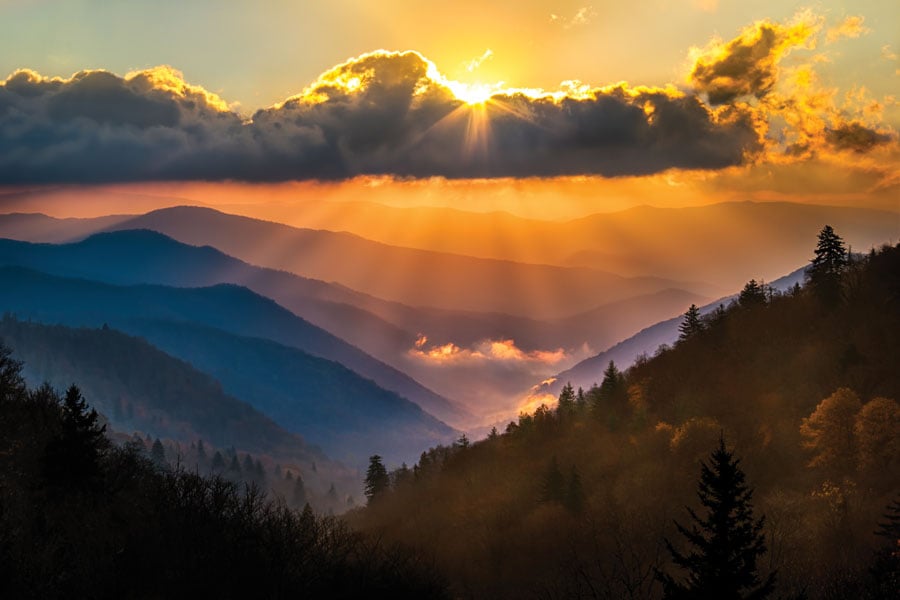Public lands and public health are under assault. Here are the eight biggest threats to parks, forests, and wildlands in the Southeast and Mid-Atlantic—and eight ways you can protect the places where you play.
National Forest Plan
The Pisgah-Nantahala National Forest in western North Carolina national forest is the second most-visited national forest in the country, with large tracts of road-free forest, important headwaters, old-growth forest, and native trout habitat. Unfortunately, the latest draft of the Forest Service’s twenty-year management plan will open much of the forest to logging and not adequately protect its most treasured recreational gems.
One of those forests—Big Ivy—has received widespread support for an expanded wilderness from mountain bikers, hikers, anglers, hunters, and the local community. County commissioners unanimously passed a resolution advocating for expanded wilderness in Big Ivy, and biologists and wildlife officials have advocated for the wilderness, too—the old-growth forest shelters over 40 rare and endangered. Unfortunately, the Forest Service has not heeded the recommendations of scientists, local leaders, or the general public. Most of Big Ivy remains unprotected in the latest draft of the management plan.
Big Ivy is not alone. Other recreational and ecological hotspots like the Black Mountains, Mackey Mountain, and Tusquitee Bald have been largely ignored by the Forest Service in its latest draft. Without protections, these areas will be open to timber harvesting for the next two decades.
“Shining Rock Wilderness Area is really heavily used, which shows that people are hungry for that kind of wilderness experience,” says Jill Gottesman, Conservation Specialist with The Wilderness Society. “But it’s not just about wilderness. It’s also about restoration, water quality, cultural heritage, and helping tourism in local gateway communities.”
What you can do
Attend Forest Service plan meetings and submit comments arguing for stronger forest protections that protect old-growth forests, clean water, and recreational resources. Send comments via email to [email protected].
Oil and Gas Drilling
In January, Arizona Rep. Paul Gosar proposed H.R. 46, a bill that would open more than 40 national parks to oil and gas drilling, including Tennessee’s Big South Fork National River and Recreation Area, West Virginia’s Gauley River National Recreation Area, and the Tennessee’s Obed Wild and Scenic River.
There are currently five national park sites in our region that have operating wells, but nine others, including Alabama’s Little River Canyon National Preserve and Kentucky’s Mammoth Cave National Park, are at risk of future development due to the split-estate condition in which the federal government owns the surface lands and private companies own the mineral rights.
Oil and gas drilling fragments wildlife migration routes and habitats, leaks into our drinking water, increases erosion and flooding potential, diminishes the outdoor recreation experience, and pollutes the air with methane. Reducing the Park Service’s authority in overseeing these operations results in direct harm to our parks.
What you can do
Tell your members of Congress that you are opposed to the weakening of oil and gas regulations in national parks. In particular, contact Republican Representative Diane Black from the 6th District of Tennessee to express your concerns—Black was one of the six representatives to cosponsor Gosar’s bill: (202) 225-4231.
Outdoor Alliance Communications Director Tania Lown-Hecht recommends adding a personal anecdote to any petitions or comments of opposition. Lown-Hecht says it’s easy to default to the suggested message copy already entered on petition forms especially, but including a short, meaningful entry about the impact these repeals would have on you and the lands you treasure can be powerful.
“Say something personal about why public lands matter to you,” she says. “State clearly what you want your congressman to do, be polite, and be kind. Their offices receive a lot of messages that are hateful,” and that, says Lown-Hecht, is not a level our parks advocates should stoop.
Fracking and Pipelines
To date, there are more than 20 pipelines proposed for the Appalachian region. Pipelines carrying fracked gas are, in and of themselves, dangerous. Leaks and explosions are common occurrences, and onshore gas pipelines built in the 2010s have accident rates more than five times greater than pipelines built just a few decades prior.
Pipelines also threaten the drinking water supply of hundreds of thousands of residents. The Mountain Valley Pipeline alone, which would stretch 301 miles from West Virginia to Virginia, crosses three major aquifers and 377 perennial waterways, including important headwater streams. Leaks from the pipeline at any point along its path can have drastic effects on everything downstream.
Three of these proposed pipelines—PennEast, Atlantic Coast, and Mountain Valley—cross the Appalachian Trail at some of its most iconic spots like Virginia’s Peters Mountain Wilderness (Mountain Valley) and Angels Rest (Atlantic Coast).

Additionally, the Atlantic Coast pipeline will cut through sensitive habitat in West Virginia’s Monongahela National Forest and Virginia’s George Washington National Forest. Visitors to the Virginia portion of the Blue Ridge Parkway will encounter great swaths of pipeline construction in Augusta and Nelson counties. Not only would these crossings disrupt wildlife habitats, but the lengthy construction period and lasting eyesores would also negatively impact recreation tourism in mountain communities that need those dollars most.
What you can do
Sign up to receive email notifications about public hearings and comment periods for pipeline developments from groups like Wild Virginia (wildvirginia.org), Sierra Club (sierraclub.org), the Allegheny-Blue Ridge Alliance (abralliance.org), Protect Our Water Heritage Rights (powhr.org), and Appalachian Voices (appvoices.org), who are leading the fight against pipelines in our region.
Though the official public comment period for the Atlantic Coast Pipeline ended April 6th, opponents are encouraged to continue voicing their concerns to the Federal Energy Regulatory Commission and their respective elected officials.
“Submit written comments, show up to public input meetings, really get involved at the local level,” says Sierra Club Virginia Chapter Director Kate Addleson. “Local folks really have the best ability to make a difference. They have strength in the community with respect to what public officials they are putting in office and then holding those officials accountable for their actions.”
Mountaintop Removal
There’s no denying the coal industry is on the decline, but it’s not dead yet. Mountaintop removal mining practices continue to destroy biologically diverse mountains and streams every day. Since the 1970s, mountaintop removal has been responsible for obliterating 500 mountains and more than 2,000 miles of headwater streams. Consequently, the water and communities downstream of these sites have abnormally high levels of heavy metals, which not only kill aquatic species but also cause increased rates in cancer and birth defects in humans.
The U.S. Environmental Protection Agency found iron and manganese concentrations surpassed drinking water guidelines in about 70 percent of the wells near reclaimed surface coal mines and sludge impoundments in Appalachia. Additionally, communities near mountaintop removal sites are at constant risk of injury to person and property from blasting as well as flooding, which is more likely to occur on mountaintop removal sites due to the lack of trees and vegetation that aid in rooting the soil and preventing erosion.
What you can do
The recent repeal of the Stream Protection Rule, which would have made it more difficult for the coal industry to dump hazardous waste into our rivers and streams, was certainly a setback, but that doesn’t mean all clean water protections are on the curb, yet.
Appalachian Voices Central Appalachian Program Manager Erin Savage says local citizens, especially those living near mining activity, should be on the lookout for stream pollution and be adamant about requesting investigations on those polluters as well as fighting any pending mining permits.
“Write things down, take photos, submit complaints, and keep copies of what you send to state agencies,” Savage says. “If you don’t hear back from them or their response is insufficient, take it up the chain, so to speak, to the federal agencies who oversee that agency. Talk to newspapers, too. Public pressure can be really helpful in convincing a state agency to take enforcement more seriously.”
As of March, there were 24 new mining permit requests in West Virginia alone, the vast majority of which were located just a stone’s throw from the New River Gorge National River. In eastern Kentucky, more than 50 new or renewal permits were pending in the 21 counties that comprise the Daniel Boone National Forest, home to such recreational gems as the Clifty Wilderness, Beaver Creek Wilderness, Red River Gorge, and the Sheltowee Trace National Recreation Trail. Mining permit applications are typically announced in local papers and can also be found online (for West Virginia, dep.wv.gov/permitting, and for Kentucky, minepermits.ky.gov) or by registering for the state mining regulatory agency’s email lists.
Finding an organization, like the Ohio Valley Environmental Coalition (ohvec.org) in West Virginia, to assist in requesting public hearings and investigations can be extremely helpful if you’re unfamiliar with the process, adds Savage.
BRO-TV: Peoples Climate March from Blue Ridge Outdoors on Vimeo.
Coal Ash
In December of 2008, 1.1 billion gallons of coal ash, the hazardous byproduct of burning coal, spilled into the Clinch and Emory rivers near Harriman, Tenn. Over 300 acres were covered in the toxic sludge, killing wildlife, destroying homes, and causing irreparable damage to the waterways for decades to come.
Less than a decade later in Eden, N.C., 39,000 tons of coal ash and 27 million gallons of contaminated water oozed into the Dan River. In some places, mounds of ash were five feet thick and the toxic waste could be traced as far as 70 miles downstream. Turtles and mussels died at an alarming rate, but even today, the spill has hardly been cleaned up.
Similar incidents have taken place across the Southeast, yet there remain no regulations on discharging toxins like arsenic, lead, and mercury into our watersheds. The Southeast is particularly at risk from further coal ash pond leaks and spills due to sparse or non-existent limitations on dumping. According to the Southern Environmental Law Center (SELC), nearly every major body of water in the Southeast has a leaking coal ash impoundment on its banks, resulting in dangerous levels of arsenic, mercury, thallium, and selenium contaminating groundwater and wells.
Despite criminal guilty pleas by Duke Energy following the 2014 Dan River spill, the North Carolina Department of Environmental Quality announced it will allow Duke Energy to continue discharging coal ash into the Dan River Basin and Roanoke River Basin at three different sites. They will also allow Duke Energy to dump toxic coal ash into some of North Carolina’s Mayo and Hyco Lakes.
In Nashville, Tenn., the SELC is in the midst of an ongoing battle to hold the Tennessee Valley Authority (TVA) accountable for the more than 27 billion gallons of coal ash wastewater that have leaked from the Gallatin Fossil Plant into the Cumberland River—Nashville’s drinking water supply for 1.2 million people). The TVA refused to supply data that proved sinkholes on the plant site, combined with unlined holding ponds, were contributing to the decreased quality of groundwater wells. Nearby wells now exceed the state water quality standards for maximum contamination levels, forcing locals to rely on bottled water.
What you can do
Want to learn if there is a coal ash impoundment near you? Visit SoutheastCoalAsh.org to see if your community is at risk.
The Trump administration froze EPA grants, which provided funding to Southern communities to reduce air and water pollution, remove lead from drinking water, and clean up hazardous waste such as coal ash. Ask your Congressional leaders to restore EPA grants and funding.
“It’s really unfortunate that some politicians have made environmental protection seem like it’s a right or left issue,” says Addleson with the Sierra Club. “It’s an issue that affects all people. Most people can agree that protecting our lands and our water and having good air quality is something that’s important.”

Abandoned Mines
Our region is still scarred by the devastating 1994-1995 mine blowouts on Muddy Creek, a tributary to West Virginia’s Cheat River. Those massive orange discharges of acid mine drainage dropped the pH in Cheat Lake to 4.5, killed fish populations over 16 miles downstream, and all but decimated the area’s booming whitewater raft industry with business down 50 percent in the following years.
The recovery process is still underway, but for the first time since the blowouts, the Cheat mainstem is home to a healthy and thriving smallmouth bass fish population. That turnaround is a direct result of the more than $5.1 million, half of which came from the EPA.
The Big South Fork National River and Recreation Area alone contains over 100 abandoned mines, many of which are contaminating this otherwise pristine park’s waterways.
What you can do
Volunteering with citizen science programs, like Appalachian Voices’ Appalachian Water Watch citizen monitoring program (appvoices.org/waterwatch), helps environmental non-profits gain the documentation and information necessary to prosecute violators of the Clean Water Act and the Surface Mine Control and Reclamation Act.
“What you do to the land, you do to the people,” Savage from Appalachian Voices adds, quoting anti-mountaintop removal activist Judy Bonds. “This isn’t as simple as jobs versus fish when you talk about clean water protection. If you protect streams, that has a lot of downstream benefits both figuratively and literally.”
Air Pollution
In July 2015, the National Parks Conservation Association released a study that found the vast majority of our 48 national parks had harmful levels of air pollution, some of which were comparable to the air pollution in major cities. On the list of top 12 parks most harmed by air pollution were Mammoth Cave National Park in Kentucky and Great Smoky Mountains National Park in North Carolina and Tennessee.
The Clean Power Plan placed carbon emission goals for each state, with an overall mission to cut national carbon emissions from the power sector by 30 percent in 2030. Unfortunately, the Trump administration has announced that it plans to dismantle the Clean Power Plan.
What you can do
Tell your elected officials to protect clean air, to keep the United States involved in the Paris Agreement, and to hold Pruitt and Tillerson accountable for their actions, which should serve the best interests of our environment’s and citizens’ health, not the industry’s.
Sign petitions to support the Clean Power Plan by visiting the Environmental Defense Fund’s website at edf.org.
Endangered Species Act
Established in 1973, the Endangered Species Act has been at the very core of conservation work. To date, the act protects more than 1,600 different species, including plants and animals. Species like the gray wolf, bald eagle, and American crocodile have not only been removed from the endangered species list but have thrived in subsequent years.
But now, thanks to a Senate hearing to “modernize the Endangered Species Act,” some Republican lawmakers are attempting to repeal the act altogether. Their argument is that the act, which has only successfully removed about 40 species from its list in its 43-year history, hinders business and controls the land in areas where the industry versus conservation war has been a longstanding battle.

Nearly driven to extinction in the 1950s, the red wolf is one of those species that is on the verge of disappearing. Fewer than 50 red wolves exist in the world, all of which reside in eastern North Carolina. Other Southern species dependent on the Endangered Species Act include the leatherback and loggerhead sea turtles, the Shenandoah salamander, the Indiana bat, and several freshwater mussels.
What you can do
Call or write to your elected officials and ask that they support the Endangered Species Act as it exists. The Southern Environmental Law Center is often spearheading efforts to protect many iconic species in the South.
And while you’re at it, make sure to spend a little quality time in the outdoors. Taking a stand for the environment is important, tireless work, but it’s important not to burn out in the early stages.
“Make sure you’re still providing yourself with the opportunities to experience the places that we must defend,” says Ani Kame’enui of the National Parks Conservation Association. “It sounds a bit silly and trite to suggest that, but that’s a huge part of this is to not get lost in the 120 characters and the volatile headlines. Continue to get into these spaces and places that have written the American story so you know what you’re fighting for.”







